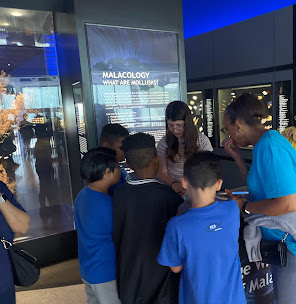Day 4: Introducing the Touch Cart
Today, I was able to work with the malacology touch cart! This was my plan for today, so I'm really happy I was able to get that done.
It was the first thing we got to do this morning, after the usual routine. Ms. Leap brought me to the "George W. Strake Hall of Malacology," where, under one of the glass exhibits, was an opening which showed a large cart specific to this exhibit. When it was closed, all you could see on the top were a bunch of gastropod shells showcased behind a glass panel. We then moved the cart to a spare room on the Ground Floor, and I got the chance to work with and study the objects the cart held inside.
Here is what I was working with today:

The cart's contents are all property of the museum and they are (almost) all available for being physically held by visitors; only some are the exception, and can only be held by the docent because of how fragile they are.
All of the specimens were arranged in specific boxes according to their class (gastropods, bivalves, cephalopods).

It is generally preferred for only 1-3 specimens be kept on top of the cart for active viewing, this is because we don't want any objects to "walk away" (as it says on the guide), and is just a safer number to keep a look on. Another standard policy is to be aware of your audience... as in, if you, the presenter, see you have a large crowd of overly-exited young children, maybe rethink handing them specimens to hold, and just show them yourself. Other than that, it is more or less judgement on the presenter's part. Pretty straight-forward!
After making sure I was familiar with standard procedures and rules, I went along and started seeing what the specimens were. As I looked through those, I took note of which I most liked, as potential options for when it came to present.
Here are some which I found really cool:
 |
| Crowned volute bailer shell |
 |
| Thorny oyster |
 |
| Large nautilus |
I tried to make use of the time by seeing what specimens were allowed to be handled by visitors, and which were not (some were labelled like that). While the others I judged myself if it would be smart to have them available to the audience. For example, one species was the "angel wing shells" or cyrtopleura costata which are really beautiful, and look, surprise surprise, like angel wings (hence the name), but they are really light and thin, so I wouldn't put them out of their casing if there was a large crowd.


Comments
Post a Comment